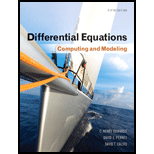
Problems 8 through 10 deal with the competition system
Show that the linearization of (3) at (0, 14) is
Want to see the full answer?
Check out a sample textbook solution
Chapter 6 Solutions
Differential Equations: Computing and Modeling (5th Edition), Edwards, Penney & Calvis
Additional Engineering Textbook Solutions
Mechanics of Materials (10th Edition)
Starting Out with C++: Early Objects (9th Edition)
Degarmo's Materials And Processes In Manufacturing
Starting Out with Java: From Control Structures through Data Structures (4th Edition) (What's New in Computer Science)
Management Information Systems: Managing The Digital Firm (16th Edition)
 Operations Research : Applications and AlgorithmsComputer ScienceISBN:9780534380588Author:Wayne L. WinstonPublisher:Brooks Cole
Operations Research : Applications and AlgorithmsComputer ScienceISBN:9780534380588Author:Wayne L. WinstonPublisher:Brooks Cole C++ for Engineers and ScientistsComputer ScienceISBN:9781133187844Author:Bronson, Gary J.Publisher:Course Technology Ptr
C++ for Engineers and ScientistsComputer ScienceISBN:9781133187844Author:Bronson, Gary J.Publisher:Course Technology Ptr

